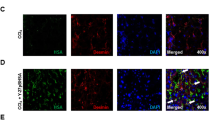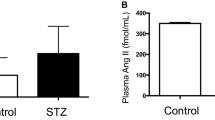Purpose
The insulin-like growth factor axis plays an important role in fibrogenesis. However, little is known about mannose-6-phosphate/Insulin-like growth factor-II receptor (M6P/IGF-IIR) expression during fibrosis. When expressed preferentially on fibrogenic cells, this receptor may be used to selectively deliver drugs to these cells. We investigated M6P/IGF-IIR expression in livers of bile duct-ligated (BDL) rats and in renal vascular walls of renin transgenic TGR(mRen2)27 rats. Both models are characterized by fibrogenic processes. Furthermore, we studied whether drug delivery via M6P/IGF-II-receptor-mediated uptake is possible in fibroblasts.
Materials and Methods/Results
M6P/IGF-IIR mRNA expression was investigated 3, 7 and 10 days after BDL. At all time-points hepatic M6P/IGF-IIR expression was significantly increased compared to healthy controls. Moreover, immunohistochemical staining revealed that α-sma-positive cells were M6P/IGF-IIR-positive. In kidneys of TGR(mRen2)27 rats, the number of M6P/IGF-IIR-positive arteries per microscopic field was increased 5.5 fold over healthy controls. To examine whether M6P/IGF-IIRs could be used as a port of entry for drugs, we coupled mycophenolic acid (MPA) to mannose-6-phosphate-modified human serum albumin (M6PHSA). M6PHSA-MPA inhibited 3T3-fibroblast proliferation dose-dependently, which was reversed by co-incubation with excess M6PHSA, but not by HSA.
Conclusions
M6P/IGF-IIRs are expressed by fibrogenic cells and may be used for receptor-mediated intracellular delivery of the antifibrogenic drug MPA.






Similar content being viewed by others
Abbreviations
- BrdU:
-
bromodeoxy uridine
- HSC:
-
hepatic stellate cell
- MPA:
-
mycophenolic acid
- M6PHSA:
-
mannose-6-phosphate-modified human serum albumin
- M6P/IGF-IIR:
-
mannose-6-phosphate/insulin-like growth factor-II receptor
- PBS:
-
phosphate buffered saline
- Ren2:
-
TGR(mRen2)27 transgenic rats
- α-sma:
-
α-smooth muscle actin
References
D. W. Powell, R. C. Mifflin, J. D. Valentich, S. E. Crowe, J. I. Saada, and A. B. West. Myofibroblasts. I. Paracrine cells important in health and disease. Am. J. Physiol. 277:C1–C9 (1999).
S. L. Friedman. Molecular regulation of hepatic fibrosis, an integrated cellular response to tissue injury. J. Biol. Chem. 275:2247–2250 (2000).
M. N. Babapulle and M. J. Eisenberg. Coated stents for the prevention of restenosis. Part I. Circulation 106:2734–2740 (2002).
M. N. Babapulle and M. J. Eisenberg. Coated stents for the prevention of restenosis. Part II. Circulation 106:2859–2866 (2002).
D. P. Faxon, V. Fuster, P. Libby, J. A. Beckman, W. R. Hiatt, R. W. Thompson, J. N. Topper, B. H. Annex, J. H. Rundback, R. P. Fabunmi, R. M. Robertson, and J. Loscalzo. Atherosclerotic vascular disease conference: Writing Group III: pathophysiology. Circulation 109:2617–2625 (2004).
I. A. Hauser, L. Renders, H. H. Radeke, R. B. Sterzel, and M. Goppelt-Struebe. Mycophenolate mofetil inhibits rat and human mesangial cell proliferation by guanosine depletion. Nephrol. Dial. Transplant. 14:58–63 (1999).
C. Heinz, T. Hudde, K. Heise, and K. P. Steuhl. Antiproliferative effect of mycophenolate mofetil on cultured human Tenon fibroblasts. Graefes Arch. Clin. Exp. Ophthalmol. 240:408–414 (2002).
A. C. Allison and T. Eunson. Mycophenolate mofetil and its mechanisms of action. Immunopharmacology 47:85–118 (2000).
Y. Ji, J. Gu, A. M. Makhov, J. D. Griffith, and B. S. Mitchell. Regulation of the interaction of inosine monophosphate dehydrogenase with mycophenolic acid by GTP. J. Biol. Chem. 281:206–212 (2006).
H. Shimizu, M. Takahashi, S. Takeda, S. Inoue, J. Fujishiro, Y. Hakamata, T. Kaneko, T. Murakami, K. Takeuchi, I. Takeyoshi, Y. Morishita, and E. Kobayashi. Mycophenolate mofetil prevents transplant arteriosclerosis by direct inhibition of vascular smooth muscle cell proliferation. Transplantation 77:1661–1667 (2004).
F. Romero, B. Rodriguez-Iturbe, H. Pons, G. Parra, Y. Quiroz, J. Rincon, and L. Gonzalez. Mycophenolate mofetil treatment reduces cholesterol-induced atherosclerosis in the rabbit. Atherosclerosis 152:127–133 (2000).
R. Greupink, H. I. Bakker, C. Reker-Smit, A. M. Loenen-Weemaes, R. J. Kok, D. K. Meijer, L. Beljaars, and K. Poelstra. Studies on the targeted delivery of the antifibrogenic compound mycophenolic acid to the hepatic stellate cell. J. Hepatol. 43:884–892 (2005).
D. R. Nelson, Z. Tu, C. Soldevila-Pico, M. Abdelmalek, H. Zhu, Y. L. Xu, R. Cabrera, C. Liu, and G. L. Davis. Long-term interleukin 10 therapy in chronic hepatitis C patients has a proviral and anti-inflammatory effect. Hepatology 38:859–868 (2003).
J. J. Maher. Interactions between hepatic stellate cells and the immune system. Semin. Liver Dis. 21:417–426 (2001).
T. Poynard, P. Mathurin, C. L. Lai, D. Guyader, R. Poupon, M. H. Tainturier, R. P. Myers, M. Muntenau, V. Ratziu, M. Manns, A. Vogel, F. Capron, A. Chedid, and P. Bedossa. A comparison of fibrosis progression in chronic liver diseases. J. Hepatol. 38:257–265 (2003).
Z. Shi, A. E. Wakil, and D. C. Rockey. Strain-specific differences in mouse hepatic wound healing are mediated by divergent T helper cytokine responses. Proc. Natl. Acad. Sci. U.S.A. 94:10663–10668 (1997).
P. J. de Bleser, P. Jannes, S. C. van Buul-Offers, C. M. Hoogerbrugge, C. F. van Schravendijk, T. Niki, V. Rogiers, J. L. van den Brande, E. Wisse, and A. Geerts. Insulinlike growth factor-II/mannose 6-phosphate receptor is expressed on CCl4-exposed rat fat-storing cells and facilitates activation of latent transforming growth factor-beta in cocultures with sinusoidal endothelial cells. Hepatology 21:1429–1437 (1995).
J. A. Weiner, A. Chen, and B. H. Davis. E-box-binding repressor is down-regulated in hepatic stellate cells during up-regulation of mannose 6-phosphate/insulin-like growth factor-II receptor expression in early hepatic fibrogenesis. J. Biol. Chem. 273:15913–15919 (1998).
P. J. de Bleser, C. D. Scott, T. Niki, G. Xu, E. Wisse, and A. Geerts. Insulin-like growth factor II/mannose 6-phosphate-receptor expression in liver and serum during acute CCl4 intoxication in the rat. Hepatology 23:1530–1537 (1996).
L. Beljaars, G. Molema, B. Weert, H. Bonnema, P. Olinga, G. M. Groothuis, D. K. Meijer, and K. Poelstra. Albumin modified with mannose 6-phosphate: a potential carrier for selective delivery of antifibrotic drugs to rat and human hepatic stellate cells. Hepatology 29:1486–1493 (1999).
M. H. de Borst, G. Navis, R. A. de Boer, S. Huitema, L. M. Vis, W. H. van Gilst, and H. van Goor. Specific MAP-kinase blockade protects against renal damage in homozygous TGR(mRen2)27 rats. Lab. Invest. 83:1761–1770 (2003).
M. J. Brosnan, A. M. Devlin, J. S. Clark, J. J. Mullins, and A. F. Dominiczak. Different effects of antihypertensive agents on cardiac and vascular hypertrophy in the transgenic rat line TGR(mRen2)27. Am. J. Hypertens. 12:724–731 (1999).
L. Beljaars, K. Poelstra, G. Molema, and D. K. Meijer. Targeting of sugar- and charge-modified albumins to fibrotic rat livers: the accessibility of hepatic cells after chronic bile duct ligation. J. Hepatol. 29:579–588 (1998).
R. J. Duncan, P. D. Weston, and R. Wrigglesworth. A new reagent which may be used to introduce sulfhydryl groups into proteins, and its use in the preparation of conjugates for immunoassay. Anal. Biochem. 132:68–73 (1983).
S. Zaina and J. Nilsson. Insulin-like growth factor II and its receptors in atherosclerosis and in conditions predisposing to atherosclerosis. Curr. Opin. Lipidol. 14:483–489 (2003).
S. Zaina, L. Pettersson, B. Ahren, L. Branen, A. B. Hassan, M. Lindholm, R. Mattsson, J. Thyberg, and J. Nilsson. Insulin-like growth factor II plays a central role in atherosclerosis in a mouse model. J. Biol. Chem. 277:4505–4511 (2002).
R. Novosyadlyy, K. Tron, J. Dudas, G. Ramadori, and J. G. Scharf. Expression and regulation of the insulin-like growth factor axis components in rat liver myofibroblasts. J. Cell Physiol. 199:388–398 (2004).
J. G. Scharf, T. Knittel, F. Dombrowski, L. Muller, B. Saile, T. Braulke, H. Hartmann, and G. Ramadori. Characterization of the IGF axis components in isolated rat hepatic stellate cells. Hepatology 27:1275–1284 (1998).
G. Pugliese, F. Pricci, N. Locuratolo, G. Romeo, G. Romano, S. Giannini, B. Cresci, G. Galli, C. M. Rotella, and U. Di Mario. Increased activity of the insulin-like growth factor system in mesangial cells cultured in high glucose conditions. Relation to glucose-enhanced extracellular matrix production. Diabetologia 39:775–784 (1996).
N. M. Dahms and M. K. Hancock. P-type lectins. Biochim. Biophys. Acta 1572:317–340 (2002).
P. A. Dennis and D. B. Rifkin. Cellular activation of latent transforming growth factor beta requires binding to the cation-independent mannose 6-phosphate/insulin-like growth factor type II receptor. Proc. Natl. Acad. Sci. U. S. A. 88:580–584 (1991).
R. Bataller, E. Gabele, C. J. Parsons, T. Morris, L. Yang, R. Schoonhoven, D. A. Brenner, and R. A. Rippe. Systemic infusion of angiotensin II exacerbates liver fibrosis in bile duct-ligated rats. Hepatology 41:1046–1055 (2005).
P. J. Admiraal, C. A. van Kesteren, A. H. Danser, F. H. Derkx, W. Sluiter, and M. A. Schalekamp. Uptake and proteolytic activation of prorenin by cultured human endothelial cells. J. Hypertens. 17:621–629 (1999).
M. M. van den Eijnden, J. J. Saris, R. J. de Bruin, E. de Wit, W. Sluiter, T. L. Reudelhuber, M. A. Schalekamp, F. H. Derkx, and A. H. Danser. Prorenin accumulation and activation in human endothelial cells: importance of mannose 6-phosphate receptors. Arterioscler. Thromb. Vasc. Biol. 21:911–916 (2001).
T. Braulke and G. Mieskes. Role of protein phosphatases in insulin-like growth factor II (IGF II)-stimulated mannose 6-phosphate/IGF II receptor redistribution. J. Biol. Chem. 267:17347–17353 (1992).
D. F. Smee, M. Bray, and J. W. Huggins. Antiviral activity and mode of action studies of ribavirin and mycophenolic acid against orthopoxviruses in vitro. Antivir. Chem. Chemother. 12:327–335 (2001).
H. Tedesco-Silva, M. C. Bastien, L. Choi, C. Felipe, J. Campestrini, F. Picard, and R. Schmouder. Mycophenolic acid metabolite profile in renal transplant patients receiving enteric-coated mycophenolate sodium or mycophenolate mofetil. Transplant. Proc. 37:852–855 (2005).
J. H. LeBowitz, J. H. Grubb, J. A. Maga, D. H. Schmiel, C. Vogler, and W. S. Sly. Glycosylation-independent targeting enhances enzyme delivery to lysosomes and decreases storage in mucopolysaccharidosis type VII mice. Proc. Natl. Acad. Sci. U. S. A. 101:3083–3088 (2004).
L. Beljaars, G. Molema, D. Schuppan, A. Geerts, P. J. de Bleser, B. Weert, D. K. Meijer, and K. Poelstra. Successful targeting to rat hepatic stellate cells using albumin modified with cyclic peptides that recognize the collagen type VI receptor. J. Biol. Chem. 275:12743–12751 (2000).
L. Beljaars, B. Weert, A. Geerts, D. K. Meijer, and K. Poelstra. The preferential homing of a platelet derived growth factor receptor-recognizing macromolecule to fibroblast-like cells in fibrotic tissue. Biochem. Pharmacol. 66:1307–1317 (2003).
Acknowledgments
This study was financially supported by the Dutch Foundation for Technical Sciences (STW), grant no GFA.5460. Prof. D.K.F. Meijer is gratefully acknowledged for valuable scientific discussion and review of the manuscript.
Author information
Authors and Affiliations
Corresponding author
Rights and permissions
About this article
Cite this article
Greupink, R., Bakker, H.I., van Goor, H. et al. Mannose-6-Phosphate/Insulin-Like Growth Factor-II Receptors may Represent a Target for the Selective Delivery of Mycophenolic Acid to Fibrogenic Cells. Pharm Res 23, 1827–1834 (2006). https://doi.org/10.1007/s11095-006-9025-2
Received:
Accepted:
Published:
Issue Date:
DOI: https://doi.org/10.1007/s11095-006-9025-2




